Japan’s green building history is a fascinating journey that showcases the country’s pioneering efforts in sustainable architecture and eco-friendly construction practices.
- Japan has a rich history in sustainable architecture and eco-friendly construction.
- Renowned architect Kengo Kuma has played a significant role in combining traditional Japanese architecture with contemporary designs.
- The yakisugi process, involving wood burning, has gained popularity for enhancing durability and aesthetic appeal.
- Fukuoka City is a leader in sustainable urban development, with the ACROS Fukuoka building showcasing green roofs and other eco-friendly features.
- While there are areas for improvement, Japan has made significant progress in incorporating sustainability into its building practices.
Reconnecting with Tradition: Influential Architects
Renowned architect Kengo Kuma founded his firm in 1990 with a vision to blend traditional Japanese architecture with contemporary designs, paving the way for sustainable building practices in the country. Kuma’s innovative approach embraces the use of natural materials such as wood, which not only adds aesthetic value but also promotes a more eco-friendly construction. His notable projects, including the Japan National Stadium and the Takanawa Gateway Station, showcase the successful integration of sustainable elements, such as natural ventilation and renewable materials, into modern designs.
One of the prominent techniques that have gained popularity in Japan’s green building history is the yakisugi process. This traditional method involves burning wood to enhance its durability and aesthetic appeal. The charred surface not only gives the wood a unique and visually striking appearance but also provides natural protection against pests and decay. The yakisugi process has become a symbol of sustainable architecture in Japan, as it showcases the country’s commitment to utilizing traditional methods in a contemporary context.
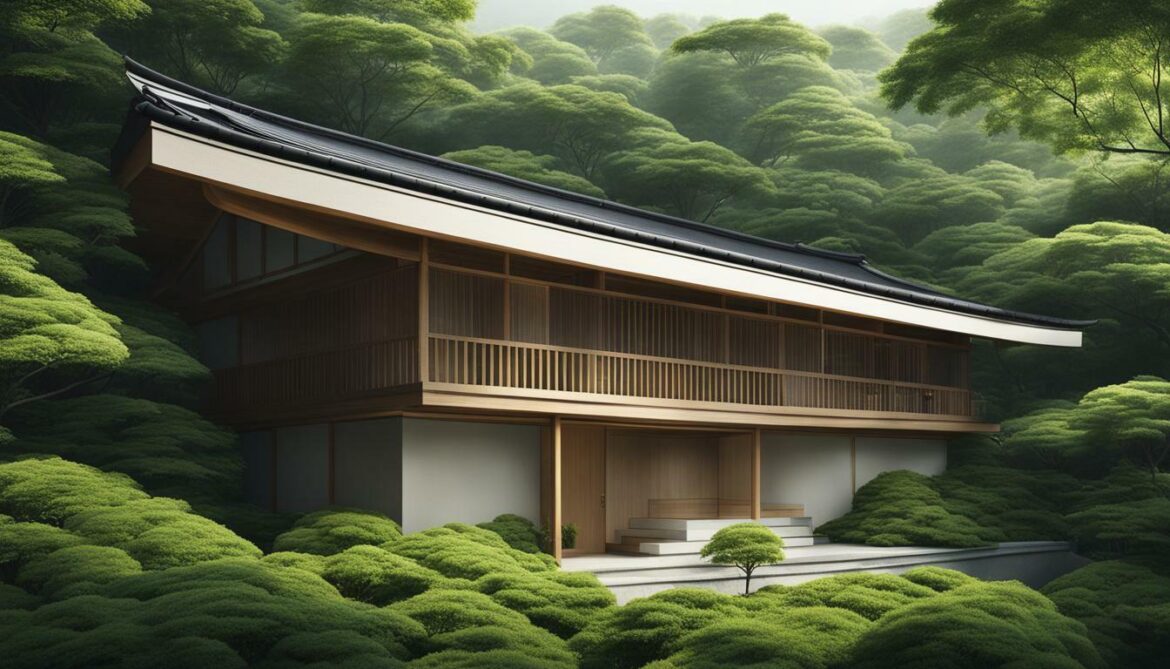
Inspiring Sustainable Designs
“I believe architecture has the power to inspire and transform society. By incorporating traditional building techniques and materials into my designs, I aim to create spaces that are not only visually stunning but also environmentally responsible,” says Kengo Kuma.
Kuma’s architectural philosophy has not only influenced other architects but has also inspired a shift towards sustainable urban development in Japan. Fukuoka City, in particular, has embraced green building practices to create a more environmentally friendly and livable city. The ACROS Fukuoka building, designed by Emilio Ambasz and Associates, stands as a testament to the city’s commitment to sustainable urban growth. The terraced green roofs of ACROS Fukuoka not only provide insulation and improve air quality but also create a vibrant habitat for wildlife within the heart of the city.
While Japan continues to make progress in incorporating sustainability into its building practices, there are still areas for improvement. Energy efficiency and renewable energy generation are two crucial aspects that need further attention to ensure a more sustainable future. By addressing these challenges and building upon its rich green building history, Japan can continue to lead the way in sustainable architecture and eco-friendly construction.
Summary:
- Kengo Kuma’s firm, founded in 1990, pioneered the blending of traditional Japanese architecture with contemporary designs, promoting sustainable building practices in Japan.
- The yakisugi process, involving burning wood for enhanced durability and aesthetics, has become an emblem of Japan’s commitment to traditional techniques in sustainable architecture.
- Architect Kengo Kuma’s philosophy has inspired sustainable urban development, with Fukuoka City leading the way in implementing green building practices.
- The ACROS Fukuoka building exemplifies sustainable urban growth, utilizing terraced green roofs to improve insulation, air quality, and provide habitat for wildlife.
- Japan’s green building practices still have room for improvement in areas such as energy efficiency and renewable energy generation.
| Architect |
Key Contributions |
| Kengo Kuma |
Blending traditional and contemporary designs, championing the use of natural materials like wood, and emphasizing sustainability |
| Emilio Ambasz and Associates |
Designing the ACROS Fukuoka building, incorporating terraced green roofs for insulation, air quality improvement, and wildlife habitat creation |
Innovative Techniques: Yakisugi Process
The yakisugi process, involving the burning of wood to enhance its durability and aesthetic appeal, has emerged as an innovative technique in Japan’s green building history. This traditional method, also known as shou sugi ban, dates back centuries and has been revitalized in contemporary architecture for its sustainable qualities. By charring the surface of the wood, the yakisugi process creates a protective layer that improves the material’s resistance to fire, insects, and decay.
Beyond its functional benefits, yakisugi-treated wood brings a unique aesthetic element to architectural designs. The rich and textured appearance of the burned surface adds depth and character to buildings, making them stand out in the urban landscape. This combination of durability and visual appeal has made the yakisugi process increasingly popular among architects and builders seeking sustainable and eye-catching materials.
To fully appreciate the transformative effect of the yakisugi process, it is essential to witness its results. As seen in the image below, the charred wood takes on an elegant, almost ebony-like appearance, complementing both modern and traditional architectural styles. The image showcases how this technique can be applied to enhance the beauty of structures while simultaneously contributing to sustainable building practices.
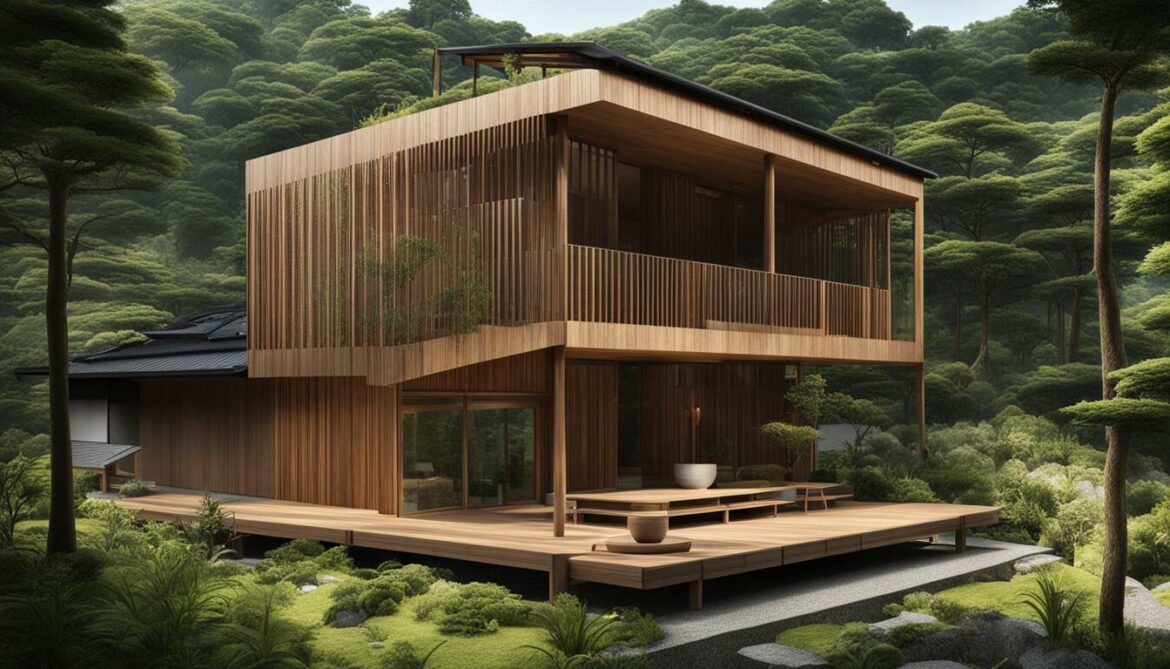
| Properties |
Yakisugi Wood |
Conventional Wood |
| Durability |
Enhanced through charring process |
Less resistant to fire, insects, and decay |
| Aesthetic Appeal |
Unique, textured appearance |
Standard, untreated surface |
| Sustainability |
Uses natural materials and reduces the need for chemical preservatives |
May require chemical treatments for longevity |
Sustainable Urbanism: Fukuoka City
Fukuoka City has emerged as a leader in sustainable urban development, exemplifying Japan’s commitment to green building practices. The city’s forward-thinking approach has paved the way for eco-friendly construction and sustainable design, making it a model for other urban centers around the world.
One notable example of Fukuoka City’s dedication to sustainability is the ACROS Fukuoka building, designed by Emilio Ambasz and Associates. This architectural marvel showcases the integration of green building practices, with its terraced green roofs that provide insulation, improve air quality, and create habitats for wildlife. The unique design not only enhances the aesthetic appeal of the building but also contributes to a healthier and greener environment.
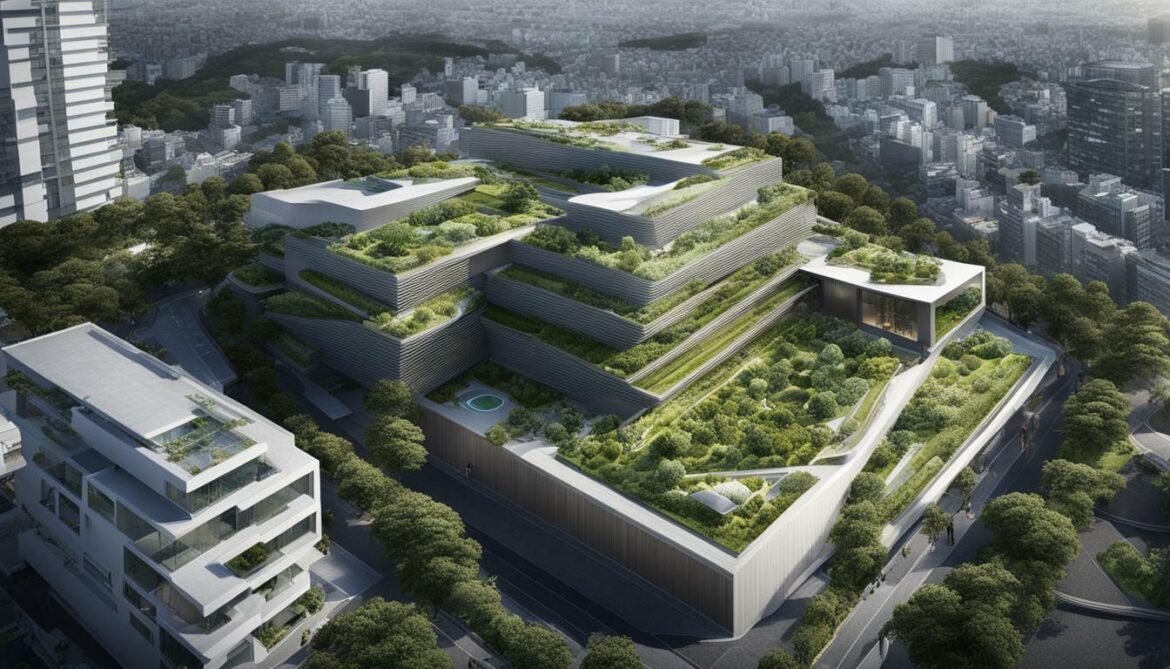
In addition to the ACROS Fukuoka building, Fukuoka City has implemented various sustainable urban development initiatives. The city has prioritized the use of renewable energy sources, such as solar power, to reduce its carbon footprint. Furthermore, Fukuoka City has focused on creating walkable neighborhoods, promoting public transportation, and encouraging the use of bicycles to minimize reliance on cars and foster a more sustainable, livable city.
Table: Fukuoka City’s Green Building Initiatives
| Initiative |
Description |
| Renewable Energy Integration |
Fukuoka City actively promotes the installation of solar panels on buildings to harness clean and renewable energy. |
| Pedestrianization |
The city has implemented measures to create pedestrian-friendly streets and reduce traffic congestion, making it easier for residents to walk or bike to their destinations. |
| Green Roofs |
Fukuoka City encourages the incorporation of green roofs in new building designs to improve insulation, reduce urban heat island effect, and enhance biodiversity. |
| Energy-Efficient Buildings |
The city has set strict energy-efficiency standards for new construction projects, encouraging developers to use sustainable materials and technologies to reduce energy consumption. |
With its commitment to sustainable urban development and green building practices, Fukuoka City continues to set an example for cities worldwide. By prioritizing environmental considerations and integrating eco-friendly solutions into its infrastructure, Fukuoka City demonstrates the positive impact that can be achieved through sustainable urbanism.
ACROS Fukuoka: A Sustainable Landmark
The ACROS Fukuoka building, designed by Emilio Ambasz and Associates, stands as a sustainable landmark, showcasing the significance of green roofs in improving insulation, air quality, and creating wildlife habitats. This iconic structure, located in the heart of Fukuoka City, exemplifies Japan’s commitment to sustainable urban growth and green building practices.
With its terraced green roofs, the ACROS Fukuoka building seamlessly integrates nature into its design, providing multiple environmental benefits. These lush green spaces not only enhance the building’s aesthetic appeal but also act as a natural insulation system, reducing the need for excessive heating or cooling. The green roofs also help improve air quality by reducing pollutants and capturing carbon dioxide.
Furthermore, the terraced green roofs of ACROS Fukuoka create vital habitats for wildlife in the urban environment. The lush vegetation attracts birds, butterflies, and other pollinators, contributing to the biodiversity of the area. It serves as a peaceful oasis amidst the bustling cityscape, allowing visitors and occupants to connect with nature.
“Green roofs are not just a way to make buildings look pretty; they are an integral part of sustainable urban development,” says architect Emilio Ambasz. “The ACROS Fukuoka building was designed with the aim of harmonizing nature and architecture, showcasing how green building practices can enhance our living spaces.”
The ACROS Fukuoka building serves as a shining example of how sustainable architecture can contribute to the well-being of both people and the planet. Its innovative design and eco-friendly features have garnered international recognition, inspiring architects and urban planners alike to prioritize sustainability in their projects. By embracing green roofs and other sustainable practices, Japan continues to lead the way towards a greener and more sustainable future.
Key Features of ACROS Fukuoka:
| Feature |
Benefits |
| Terraced green roofs |
Improves insulation and reduces energy consumption |
| Air purification |
Reduces air pollution and improves overall air quality |
| Wildlife habitat |
Creates a biodiverse environment and promotes urban biodiversity |
| Integration of nature |
Enhances the overall aesthetic appeal of the building |
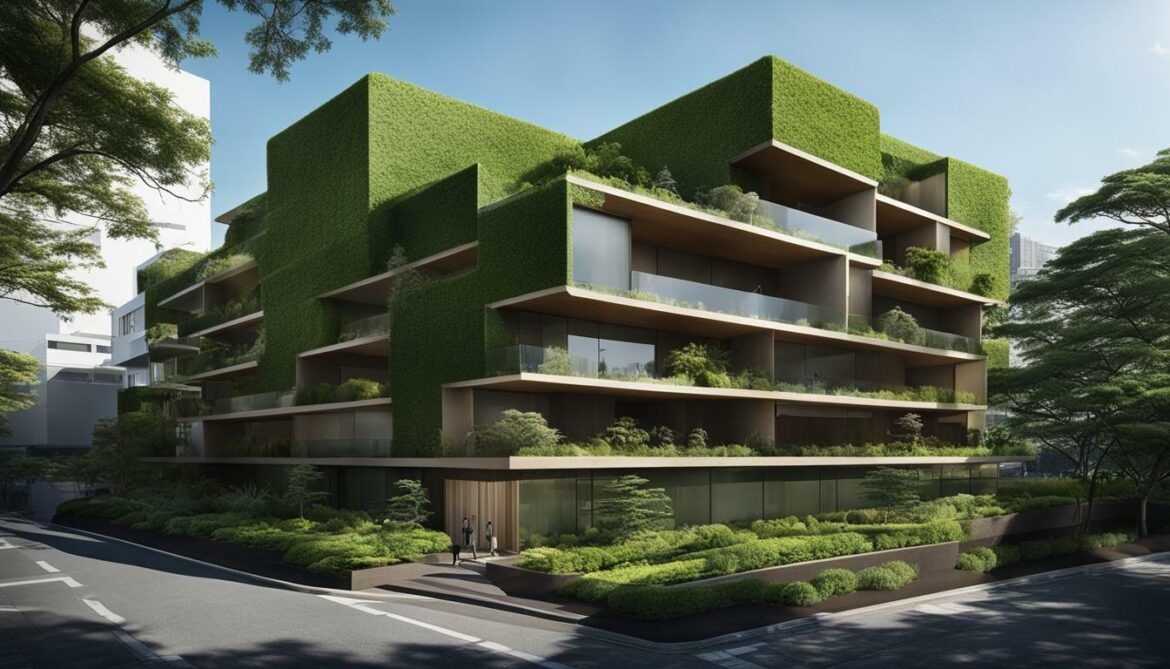
While Japan has made significant progress in incorporating sustainability into its building practices, there are still areas for improvement, such as energy efficiency and renewable energy generation. These factors play a crucial role in reducing carbon emissions and promoting long-term environmental sustainability.
One area for improvement is energy efficiency. Japan has a high energy consumption rate, and buildings account for a significant portion of this energy usage. Implementing energy-efficient technologies and practices can help reduce energy consumption and lower carbon footprints. For example, incorporating insulation materials and efficient heating, ventilation, and air conditioning (HVAC) systems can optimize thermal comfort and reduce the need for excessive energy consumption.
Renewable energy generation is another aspect that requires attention. While Japan has made strides in promoting renewable energy sources such as solar and wind power, there is still room for further development. Increasing the installation of solar panels on rooftops and implementing wind turbines in suitable locations can contribute to a more sustainable energy mix and reduce dependence on fossil fuels.
By focusing on improving energy efficiency and expanding renewable energy generation, Japan can continue to lead the way in sustainable building practices. Embracing innovative technologies, adopting stricter energy standards, and incentivizing green building initiatives can further accelerate progress in achieving a more sustainable and eco-friendly built environment.
“Implementing energy-efficient technologies and practices can help reduce energy consumption and lower carbon footprints.”
Energy-Efficiency Measures
| Energy-Efficiency Measures |
Benefits |
| Insulation |
Optimizes thermal comfort and reduces heating and cooling energy requirements. |
| Efficient HVAC Systems |
Reduces energy consumption for heating, ventilation, and air conditioning while maintaining indoor comfort. |
| LED Lighting |
Significantly reduces electricity usage compared to traditional incandescent or fluorescent lighting. |
Renewable Energy Potential
Japan has a vast potential for renewable energy generation. By leveraging its geographical advantages, the country can tap into various renewable sources, including solar, wind, hydro, and geothermal energy. Here are some key facts about Japan’s renewable energy potential:
- Japan is rich in solar energy resources, especially in the southern regions with ample sunlight.
- The country also has significant wind power potential, particularly along its coastlines and mountainous areas.
- Hydroelectric power, utilizing Japan’s rivers and waterways, can contribute to the renewable energy mix.
- Geothermal energy, harnessed from the country’s volcanic activity, can provide a stable and sustainable energy source.
By harnessing these renewable energy sources and implementing supportive policies, Japan can achieve a more diversified and sustainable energy portfolio, reducing its reliance on fossil fuels and contributing to a greener future.

- Japan has made substantial progress in incorporating sustainability into its building practices.
- Energy efficiency improvements can be achieved through insulation, efficient HVAC systems, and LED lighting.
- Renewable energy potential in Japan includes solar, wind, hydro, and geothermal sources.
- Continued efforts in energy efficiency and renewable energy generation will propel Japan towards a more sustainable and eco-friendly built environment.
With a focused approach on energy efficiency and renewable energy generation, Japan can continue to pave the way for sustainable building practices. By implementing innovative solutions and embracing a greener future, the country can create a more sustainable environment for generations to come.
Renewable Energy Sources in Japan
| Renewable Energy Sources |
Potential Benefits |
| Solar Power |
Ample sunlight resources for widespread solar panel installation. |
| Wind Power |
Coastlines and mountainous areas provide suitable conditions for generating wind energy. |
| Hydroelectric Power |
Utilizing rivers and waterways to generate clean energy. |
| Geothermal Energy |
Tapping into volcanic activity to harness a stable and sustainable energy source. |
Progress and Future Outlook
Japan’s green building history showcases the country’s commitment to sustainability, with significant progress made and a promising future outlook for eco-friendly construction. Renowned architects like Kengo Kuma have pioneered the use of traditional Japanese materials and techniques in contemporary designs, setting the stage for a more environmentally conscious approach to architecture. By incorporating sustainable practices, such as the use of wood and natural ventilation, Kuma’s projects have demonstrated the harmonious blend of tradition and innovation in green building.
An innovative technique that has gained popularity in Japan is the yakisugi process, which involves burning wood to enhance its durability and aesthetic appeal. This technique not only adds a unique character to the buildings but also increases the lifespan of the wood, reducing the need for frequent replacements and minimizing environmental impact.
In terms of sustainable urbanism, Fukuoka City has emerged as a pioneer in implementing green building practices. Notably, the ACROS Fukuoka building, designed by Emilio Ambasz and Associates, stands as a testament to sustainable urban growth. With its awe-inspiring terraced green roofs, this architectural marvel provides insulation, improves air quality, and creates habitat for wildlife, contributing to a greener and more livable city.
While Japan has made significant progress in promoting sustainability in its building practices, there are still areas for improvement. Energy efficiency and renewable energy generation remain key challenges that need to be addressed in order to further reduce carbon emissions and enhance the overall sustainability of the built environment. Continued research and innovation in these areas will play a crucial role in shaping the future of green construction in Japan.
| Key Points: |
| Japan’s green building history showcases a commitment to sustainability |
| Pioneering architects have blended traditional and contemporary designs |
| The yakisugi process enhances wood’s durability and aesthetic appeal |
| Fukuoka City leads the way in sustainable urban development |
| Energy efficiency and renewable energy generation are areas for improvement |
Japan’s progress in green building practices is a positive indication of the nation’s commitment to sustainability. As architects and designers continue to explore innovative techniques, incorporate traditional elements, and prioritize eco-friendly construction, the future outlook for green building in Japan appears promising. By addressing the challenges of energy efficiency and renewable energy generation, Japan has the potential to further enhance its position as a global leader in sustainable architecture and construction.
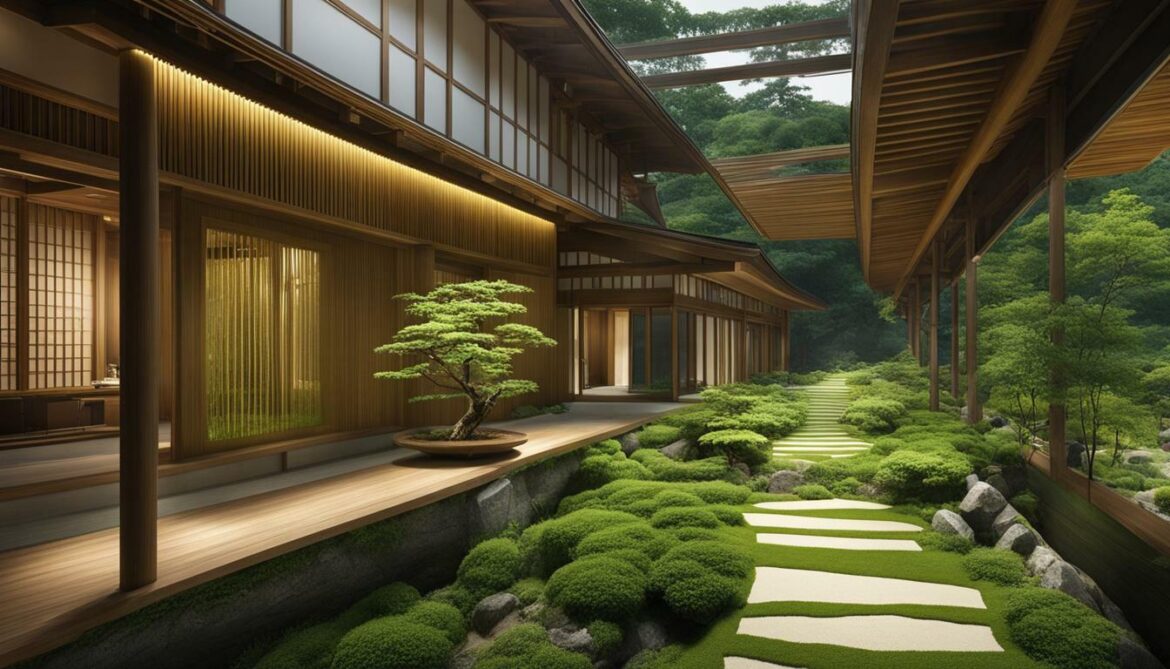
- Japan’s green building history highlights its commitment to sustainability
- Architects like Kengo Kuma have blended tradition and innovation in their designs
- The yakisugi process enhances wood’s durability and aesthetic appeal
- Fukuoka City leads in sustainable urban development with projects like ACROS Fukuoka
- Energy efficiency and renewable energy generation remain areas for improvement
Conclusion
In conclusion, Japan’s green building history is a testament to its dedication to sustainable architecture and eco-friendly construction practices, setting an example for green building initiatives worldwide.
Japan’s journey towards sustainable architecture began with influential architects like Kengo Kuma, who sought to reconnect with traditional materials and techniques. By combining traditional Japanese architecture with contemporary designs, Kuma’s projects, such as the Japan National Stadium and Takanawa Gateway Station, showcase the use of wood and natural ventilation for sustainability.
Another noteworthy technique that has gained popularity in Japan is the yakisugi process. This unique method involves burning wood to enhance its durability and aesthetic appeal. The yakisugi process has not only contributed to the longevity of wooden structures but also added a distinctive charm to Japan’s architectural landscape.
When it comes to sustainable urbanism, Fukuoka City has emerged as a leader in incorporating green building practices. The ACROS Fukuoka building, designed by Emilio Ambasz and Associates, is a prime example of sustainable urban growth. Its terraced green roofs not only provide insulation and improve air quality but also create a habitat for wildlife, showcasing the integration of nature within an urban environment.
While Japan’s green building practices have made significant progress, there are still areas for improvement. Energy efficiency and renewable energy generation are two key aspects that require further attention. However, Japan’s commitment to sustainability in its building practices serves as a model for other nations to follow.
Japan’s green building history signifies its unwavering dedication to sustainable architecture, eco-friendly construction, and green building initiatives. By embracing innovative techniques, reconnecting with tradition, and prioritizing sustainable urbanism, Japan has set a remarkable precedent for the global construction industry.
FAQ
What is the history of green building in Japan?
Japan’s green building history can be traced back to the efforts of contemporary architects who sought to reconnect with traditional materials and techniques.
Who are some influential architects in Japan’s green building history?
Renowned architect Kengo Kuma founded his firm in 1990 with a vision to combine traditional Japanese architecture with contemporary designs.
What is the yakisugi process and how is it used in Japan?
The yakisugi process involves burning wood to enhance its durability and aesthetic appeal, and it has gained popularity in Japan.
Which city in Japan has been a leader in green building practices?
Fukuoka City has been a leader in implementing green building practices and sustainable urbanism.
What is the ACROS Fukuoka building and why is it significant?
The ACROS Fukuoka building, designed by Emilio Ambasz and Associates, exemplifies sustainable urban growth with its terraced green roofs, which provide insulation, improve air quality, and create habitat for wildlife.
What are some areas for improvement in Japan’s green building practices?
Japan still has room for improvement in areas such as energy efficiency and renewable energy generation.
What progress has Japan made in incorporating sustainability into its building practices?
Japan has made significant progress in incorporating sustainability into its building practices, although there are still challenges to overcome.
What is the future outlook for green construction in Japan?
Japan’s green building initiatives are expected to continue growing in the future, with more focus on sustainability and eco-friendly construction.
Source Links
























Post comments (0)